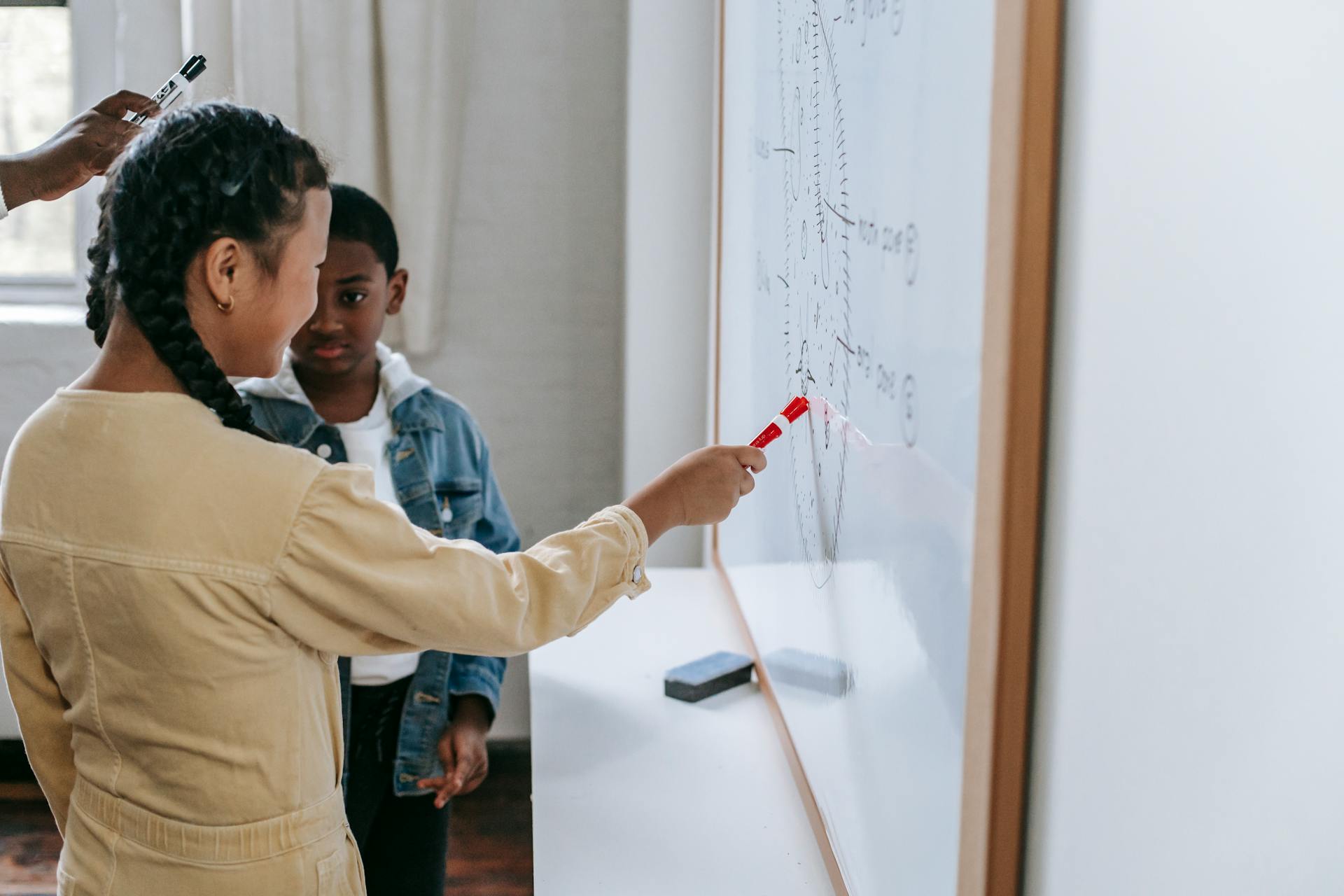
A learning curve in machine learning is a graphical representation of the relationship between the number of training examples and the model's performance. It's a crucial concept to grasp, as it helps you understand how your model will behave as it learns from more data.
The shape of the learning curve can be steep or shallow, depending on the complexity of the problem and the size of the training dataset. A steep curve indicates that the model is learning quickly, while a shallow curve suggests that it's not improving much with additional data.
In some cases, the learning curve can be U-shaped, indicating that the model is overfitting to the training data initially and then improves as it generalizes to new data. This can happen when the model is too complex and needs more data to regularize itself.
Training and Validation
Training and validation are crucial steps in the machine learning process. You want to make sure your model is learning effectively and not just memorizing the data.
High training loss is a sign of struggle, indicating that the network is underfitting and not learning effectively. This can happen when the model is not complex enough to capture the patterns in the data.
To evaluate your model's performance, you need to test it against a validation set. If the training loss is low but the validation loss is high, it signals overfitting. The model isn't truly learning; it's just memorizing the training data.
A learning curve can help you identify whether your model is overfitting or underfitting. If the training loss improves but the validation loss shows a large gap, it may indicate an unrepresentative train dataset. This can occur when the training dataset has too few examples or features with less variance than the validation dataset.
To address this issue, you can try adding more observations to the training dataset or incorporating data augmentation to increase feature variability. Make sure you're randomly sampling observations to use in your training and validation sets.
On the other hand, an unrepresentative validation dataset can occur when the validation dataset has too few examples compared to the training dataset. This can be identified by a learning curve for training loss that looks like a good fit and a learning curve for validation loss that shows noisy movements and little or no improvement.
Discover more: Transfer Learning vs Few Shot Learning
To fix this issue, you can try adding more observations to the validation dataset or performing cross-validation. This will ensure that all your data has the opportunity to be represented in both the training and validation sets.
Here are some common signs of an unrepresentative validation dataset:
- Validation loss is lower than training loss, no matter how many training iterations you perform
- Information leakage, where a feature in the training data has direct ties to observations and responses in the validation data
- Poor sampling procedures, where duplicate observations exist in the training and validation datasets
- Validation dataset contains features with less variance than the training dataset
To address these issues, you can check for duplicate observations, information leakage, and inconsistent feature variance across the training and validation datasets. You can also perform cross-validation to ensure that all your data has the opportunity to be represented in both the training and validation sets.
The Bias-Variance Trade-Off
As we explore the learning curve, it's essential to understand the bias-variance trade-off. A model is underfit if it's unable to learn the patterns in the data properly, resulting in a low score on both the training set and test/validation set.
This is because an underfit model doesn't fully learn each and every example in the dataset. This can happen when the model is too simple or when the data is too complex.
On the other hand, an overfit model learns each and every example so perfectly that it misclassifies an unseen/new example. This results in a perfect or close to perfect training set score while a poor test/validation score.
The bias-variance trade-off is all about finding the right balance between these two extremes. A model that's too simple will underfit the data, while a model that's too complex will overfit the data.
You might enjoy: Inception Score
Types of Errors
Machine learning models can make different types of errors, which can be broadly classified into bias, variance, and overfitting.
Bias errors occur when a model is too simple and fails to capture the underlying patterns in the data, resulting in a poor fit.
Variance errors, on the other hand, occur when a model is too complex and starts to fit the noise in the data, resulting in overfitting.
Overfitting happens when a model is so complex that it starts to memorize the training data, rather than learning the underlying patterns.
If this caught your attention, see: Bias Variance Decomposition
What About Classification?
In classification tasks, the workflow is almost identical to regression, but you'll need to choose a different error metric to evaluate performance.
The main difference between regression and classification is the type of error metric used. For classification, accuracy is a suitable metric because it describes how good the model is, with higher accuracy being better.
Unlike in regression, where the lower the Mean Squared Error (MSE), the better, in classification, the higher the accuracy, the better. This has implications for the irreducible error.
For error metrics that describe how bad a model is, like MSE, the irreducible error gives a lower bound. You can't get lower than that.
For error metrics that describe how good a model is, like accuracy, the irreducible error gives an upper bound. You can't get higher than that.
The Bayes error rate is another term used to refer to the best possible error score of a classifier, and it's analogous to the irreducible error.
For your interest: Automatic Document Classification Machine Learning
Good Fit Features
A good fit model is characterized by a learning curve that shows close values between cross-validation and training accuracy. This is what happens when we set the inverse regularization parameter 'c' to 1, essentially turning off regularization.
The learning curve of a good fit model also exhibits certain typical features. Training loss and validation loss are close to each other, with validation loss being slightly greater than the training loss.
Initially, both training and validation loss decrease, but then they level off and remain pretty flat until the end. This indicates a well-fitting model that generalizes well to unseen data.
If this caught your attention, see: Auto Ml Fit Succeeded
Characteristics of Errors
Learning from mistakes is an essential part of the machine learning process, and errors can be categorized into different types.
Type I errors occur when the model incorrectly identifies a positive instance as negative, which can be due to overfitting.
Overfitting can lead to poor performance on new, unseen data, causing the model to fit the noise in the training data.
Curious to learn more? Check out: Learning with Errors
Type II errors happen when the model fails to identify a negative instance as positive, often due to underfitting.
Underfitting can result in a model that's too simple and fails to capture the underlying patterns in the data.
Both types of errors can be costly in real-world applications, where even a small mistake can have significant consequences.
Underfit Characteristics
An underfit model is unable to learn the patterns in the data properly, resulting in a low score on both the training set and test/validation set.
Underfitting can be identified by a flat line or noisy values of relatively high loss in the training learning curve, indicating that the model was unable to learn the training dataset at all.
A common signal for underfitting is a sudden dip in the training loss and validation loss at the end of the learning curve, which may not always happen.
There are several ways to address underfitting, including adding more observations, adding more features, reducing regularization on the model, and increasing model capacity.
Here are some specific actions you can take to address underfitting:
- Add more observations: You may not have enough data for the existing patterns to become strong signals.
- Add more features: Occasionally our model is under-fitting on the grounds that the feature items are insufficient.
- Reduce any regularization on the model: If you have explicit regularization parameters specified (i.e. dropout, weight regularization), remove or reduce these parameters.
- Increase model capacity: Your model capacity may not be large enough to capture and learn existing signals.
Additionally, an underfit model may be identified by a training and validation loss that are continuing to decrease at the end of the plot, indicating that the model is capable of further learning and that the training process was halted prematurely.
In such cases, you can try increasing the number of epochs until the validation curve has stopped improving, and add an early stopping callback to identify how many epochs are required.
Overfit Characteristics
An overfit model is characterized by its ability to perfectly learn the training data, including statistical noise and random fluctuations. This can be identified by looking at the learning curve.
The training loss and validation loss are far away from each other, indicating that the model is overfitting to the training data. This is a common trait of overfit models.
A typical feature of an overfit model's learning curve is that the training loss continues to decrease with experience, while the validation loss has decreased to a minimum and has begun to increase. This indicates that the model is learning too much from the training data.
Overfitting is apparent when the training loss continues to decrease with experience, while the validation loss has decreased to a minimum and has begun to increase. This is a key characteristic of overfit models.
A model that overfits early and has a sharp "U" shape often indicates overcapacity and/or a learning rate that is too high. This can be a sign that the model is learning too much from the training data.
Here are some common characteristics of overfit models:
- Training loss and validation loss are far away from each other.
- Training loss continues to decrease with experience, while validation loss has decreased to a minimum and has begun to increase.
- Model learns too much from the training data, including statistical noise and random fluctuations.
- Model has a sharp "U" shape, indicating overcapacity and/or a learning rate that is too high.
A Good Fit
A good fit model is one where the training loss and validation loss are close to each other, with validation loss being slightly greater than the training loss.
In fact, when we get a good fit model, cross validation accuracy and training accuracy are close to each other. This is a good sign that our model is generalizing well.
The plot of training loss and validation loss for a good fit model will show initially decreasing training and validation loss, followed by a pretty flat training and validation loss after some point till the end.
Here are the typical features of a good fit model:
- Training loss and Validation loss are close to each other with validation loss being slightly greater than the training loss.
- Initially decreasing training and validation loss and a pretty flat training and validation loss after some point till the end.
Sources
- https://www.dataquest.io/blog/learning-curves-machine-learning/
- https://medium.com/@juanc.olamendy/understanding-the-learning-curves-in-ml-2ec442d91b8f
- https://rstudio-conf-2020.github.io/dl-keras-tf/notebooks/learning-curve-diagnostics.nb.html
- https://towardsdatascience.com/learning-curve-to-identify-overfitting-underfitting-problems-133177f38df5
- https://nvsyashwanth.github.io/machinelearningmaster/learning-curves/
Featured Images: pexels.com


